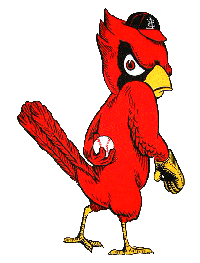
| Illuminations Home |
|
| St.
Louis Cardinals |
|
| Von der Ahe Years |
|
| Gashouse Baseball |
|
| St. Louis Swifties |
|
| Beginning
of the Busch Era |
|
| Gibby
and El Birdos |
|
| Whiteyball | |
| Enter
the "Genius" |
|
| Baseball Heaven |
|
| Visiting Busch Stadium |
|
| Do the Cubs Really Suck? |
|
Illuminations, Epiphanies, & Reflections
Gibby and El Birdos
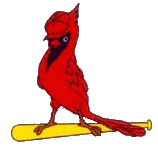
(How about some background music?)
|
Auggie Busch had the reputation of not being a very patient man, so while he was no doubt pleased about the prospect of his team playing in a new downtown park, he surely must have found the Cardinals' mediocre on-field performance through first decade of his ownership considerably trying. No doubt, he didn't find the movie made from It Happens Every Spring From 1954 to 1963, the Cardinals didn't play much better than .500 baseball, only finished second twice, and never came close to winning a pennant. That all changed in 1964. 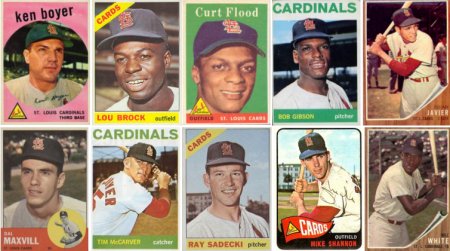 Two pitchers who had already spent several years with the Cardinals blossomed during the year. Ray Sadecki, who had been with the Cardinals since 1960, went 21-11, and Bob Gibson, who had been with the Redbirds since 1959, turned in a 19-12 record. Ken Boyer, who was recognized as the National League's Most Valuable Player of 1964, had his typically outstanding year at third base and a career year at the plate driving in 119 runs. Still, the Cardinals didn't really click until they acquired a young outfielder from the Cubs at the trading deadline in exchange for veteran pitcher, Ernie Broglio. The Cubs had given up on Lou Brock, and Cardinal manager Johnny Keane convinced General Manager Bing Devine that the speedster would thrive with St. Louis. He did; Brock hit .348 for the rest of the year and stole 38 bases. Still, the Cardinals trailed the first place Philadelphia Phillies by six and 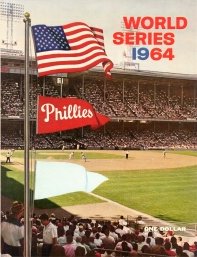 one-half games on 21 September and faced an 18-game
road trip.
Incredibly, the Cardinals caught fire, and the Phillies collapsed losing ten straight
games. By the time the Redbirds
returned home for their final three games of the season, they led the
second place Cincinnati Reds by one game. The National League
title came down to the final game against the New York Mets. I
remember listening to Harry Caray's excitement grow with Auggie Busch shouting in the background as the Cardinals came down to the final out in an 11-5
victory. When Tim McCarver
caught Ed one-half games on 21 September and faced an 18-game
road trip.
Incredibly, the Cardinals caught fire, and the Phillies collapsed losing ten straight
games. By the time the Redbirds
returned home for their final three games of the season, they led the
second place Cincinnati Reds by one game. The National League
title came down to the final game against the New York Mets. I
remember listening to Harry Caray's excitement grow with Auggie Busch shouting in the background as the Cardinals came down to the final out in an 11-5
victory. When Tim McCarver
caught Ed 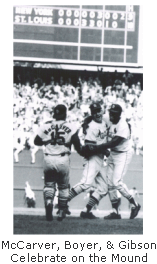 Kranepool's pop foul,
bedlam reigned on the field as St. Louis had won it's first pennant in
18 years. Kranepool's pop foul,
bedlam reigned on the field as St. Louis had won it's first pennant in
18 years. The World Series with the New York Yankees was every bit as exciting as the last three weeks of the regular season. The series went back and forth for the first six games with Cardinal homers by Mike Shannon and Tim McCarver being the key blows in Games 1 and 6, but nothing was more exciting than Ken Boyer's grand slam off Al Dowling that beat the Yankees 4-3 in Game 4. Bob Gibson took the mound for St. Louis in Game 7, the radio broadcast of which is available at mlb.com, pitching on only two days rest and set a record for World Series strike-outs. Although he tired badly in ninth, giving up two home-runs, he managed to struggle through the inning and win his third game of the Series. Interestingly, the Cardinals cleaned house over the next two years to make room for the youngsters who had cut their teeth in the team's 1964 season, releasing Ray Sadecki, Ken Boyer, and All-Star first baseman (and future National League President) Bill White. By the time the new Busch Stadium opened in 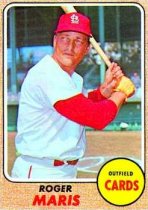 downtown St. Louis, a three- way trade over two years had swapped Boyer for the Mets Charlie
Smith, who the Cardinals, in turn, shipped to the Yankees for home-run
champion Roger Maris. Maris, who had never been a favorite of
Yankee
fans, had fallen into disfavor with CBS, the new owners of the
Yankees. During his first series at Busch Stadium, Maris was
amazed to find that he received repeated tumultuous welcomes every time
he stepped to the plate. downtown St. Louis, a three- way trade over two years had swapped Boyer for the Mets Charlie
Smith, who the Cardinals, in turn, shipped to the Yankees for home-run
champion Roger Maris. Maris, who had never been a favorite of
Yankee
fans, had fallen into disfavor with CBS, the new owners of the
Yankees. During his first series at Busch Stadium, Maris was
amazed to find that he received repeated tumultuous welcomes every time
he stepped to the plate. More important to the Cardinals, the Sadecki trade brought San Francisco slugger, Orlando 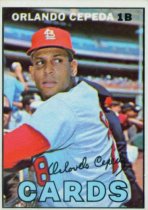 Cepeda, to the St. Louis. Cepeda had been a fan favorite
in the Bay Area since he broke into the league in 1958 despite the
resentment and animosity shown him by Willie Mays. More
problematic, he had consistent run-ins with Giants management,
especially over the team's ban on speaking Spanish in the dugout and on
the field and playing salsa music in the clubhouse. The trade for
Sadecki
caught Cepeda completely by surprise, and it is said he cried all the
way
to St. Louis. Upon arrival, however, his tears quickly dried when
Cepeda, to the St. Louis. Cepeda had been a fan favorite
in the Bay Area since he broke into the league in 1958 despite the
resentment and animosity shown him by Willie Mays. More
problematic, he had consistent run-ins with Giants management,
especially over the team's ban on speaking Spanish in the dugout and on
the field and playing salsa music in the clubhouse. The trade for
Sadecki
caught Cepeda completely by surprise, and it is said he cried all the
way
to St. Louis. Upon arrival, however, his tears quickly dried when
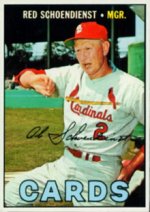 he found he could speak Spanish to his heart's content with All-Star
second baseman, Julian Javier, and Cardinal broadcaster, Jack
Buck. Even better, manager Red Schoendienst encouraged Cepeda to
bring his music into the locker room, and christened him
"Cha-Cha." Cepeda returned the favor by christening the
Cardinals, "El Birdos," a nickname that took St. Louis by storm in the
late 1960s and is still occasionally used in referring to the team
today. Following each victory, Cha-Cha would climb up on a trunk
in the locker room and lead the team in cheers. He became the
heart of the Cardinals, both emotionally
and on the field, batting .325, driving in 111 runs, and being named
the Most Valuable Player for 1967. he found he could speak Spanish to his heart's content with All-Star
second baseman, Julian Javier, and Cardinal broadcaster, Jack
Buck. Even better, manager Red Schoendienst encouraged Cepeda to
bring his music into the locker room, and christened him
"Cha-Cha." Cepeda returned the favor by christening the
Cardinals, "El Birdos," a nickname that took St. Louis by storm in the
late 1960s and is still occasionally used in referring to the team
today. Following each victory, Cha-Cha would climb up on a trunk
in the locker room and lead the team in cheers. He became the
heart of the Cardinals, both emotionally
and on the field, batting .325, driving in 111 runs, and being named
the Most Valuable Player for 1967. 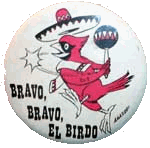 The Cardinals jumped off to a hot start in 1967, but
in June disaster
struck; Johnny Roseboro broke Ray Washburn's hand
with a line drive. and one month later, Roberto
Clemente broke Bob Gibson's leg with another line shot, sidelining him as well. Things
looked pretty bleak for the Cardinals, but rookies Dick Hughes and Steve Carlton stepped in
along with relief pitcher, Nelson Briles, for a combined record of
44-20. By the close of the
regular season, St. Louis had won 101 games and led the second place
San Francisco Giants
by ten and one-half games. The Cardinals jumped off to a hot start in 1967, but
in June disaster
struck; Johnny Roseboro broke Ray Washburn's hand
with a line drive. and one month later, Roberto
Clemente broke Bob Gibson's leg with another line shot, sidelining him as well. Things
looked pretty bleak for the Cardinals, but rookies Dick Hughes and Steve Carlton stepped in
along with relief pitcher, Nelson Briles, for a combined record of
44-20. By the close of the
regular season, St. Louis had won 101 games and led the second place
San Francisco Giants
by ten and one-half games. In the 1967 World Series against the Boston, St. Louis found most of the country pulling for the Red Sox to break their 50 year Curse of the Bambino. But that was not to be. Lou Brock, Mike Shannon, Tim McCarver, Orlando Cepeda, Roger Maris, and Julian Javier all contributed key hits throughout the series, and Gibson again was spectacular. 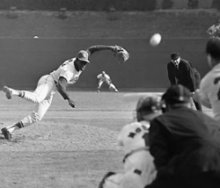 Gibby, the World Series Most Valuable Player,
once more won three games, allowing only three runs in 27 innings, and
hit the game-winning home run again Red Sox ace, Jim Lonborg in Game 7. Gibby, the World Series Most Valuable Player,
once more won three games, allowing only three runs in 27 innings, and
hit the game-winning home run again Red Sox ace, Jim Lonborg in Game 7.1968 was another great season for the Cardinals, and they again won the pennant with a record of 97-65, finishing nine games in front of the San Francisco Giants. Bob Gibson was more dominating than ever before, pitching over 300 innings with an earned run average of on 1.18. Gibson struck out 17 Tigers in Game 1, and won Game 4 as well. Unfortunately after going up three games to one against the Detroit Tigers, the series began to fall apart for the Redbirds after Lou Brock was called out at the plate on a controversial play in Game 5. Denny McClain held them to only one run in Game 6, and when Curt Flood badly misplayed a routine fly ball in Game 7 allowing three runs to score in the fifth inning, the Series was over for the Cardinals. For more information: |